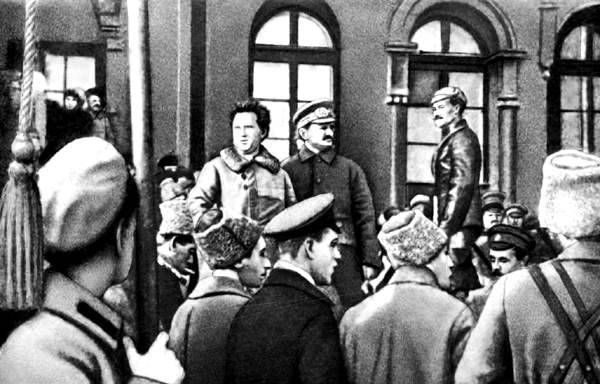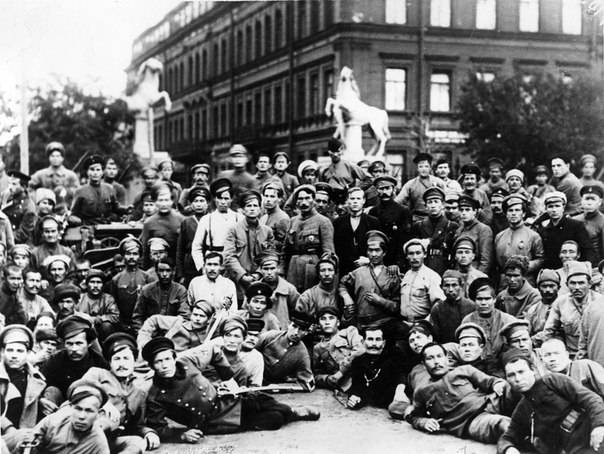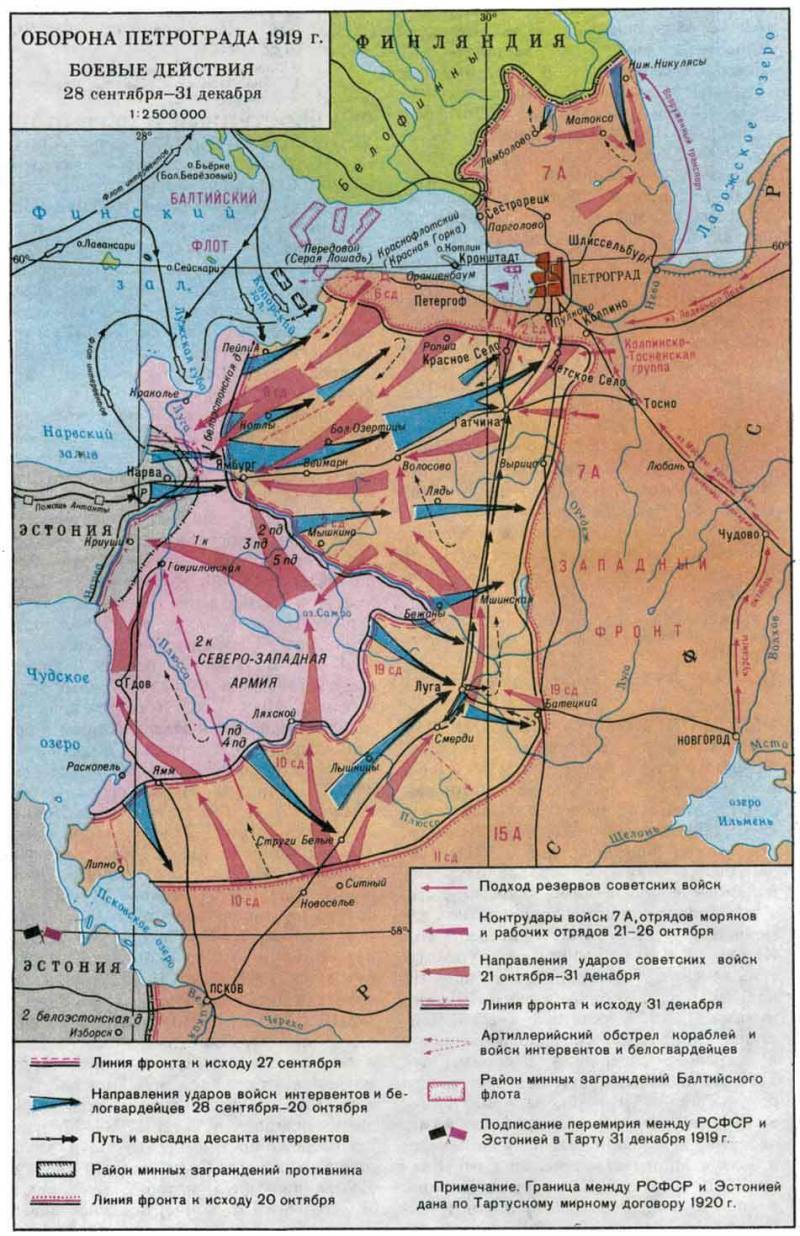"Do not give up Petrograd!" The fierce battle for the cradle of revolution

The Northwest Army, pursuing the Reds who were retreating in a panic, made transitions with battles along 30 – 40 kilometers per day. On October 18, General Yudenich ordered the 1 Corps of the North-West Army to launch an assault on Petrograd. On October 19, the 5 I White Lebanese Division captured the village of Ligovo, and by the evening of October 20, the troops of the 7 Red Army retreated to the Pulkovo Heights line, the last tactical line on the way to the northern capital.
Red Army Defense Breakthrough
The White Command was counting on occupying Petrograd by a sudden and powerful blow to the shortest direction Yamburg - Gatchina. Part of the generals of the Northwest Army (NWA) believed that before attacking Petrograd, it was necessary to secure the southern flank, take Pskov, or even choose the main Pskov direction. However, the prevailing opinion of those commanders who believed that success in a maneuvering civil war would bring a blow by the main forces in the shortest direction to Petrograd, despite the situation on the flanks. In the Pskov and Luga directions, only auxiliary, distracting strikes were inflicted. NWF flanks covered Estonian troops: in the north - the 1th Estonian Division, in the south (Pskov direction) - the 2th Estonian Division.
The Red Command, weakened by the apparent weakness of the previously defeated NWA, by peaceful negotiations with Estonia, missed the enemy’s preparations for the offensive. The intelligence was poorly set and did not reveal the plans of the White Guards. In addition, when as a result of the September counterattack of the Red Army the whites were defeated and driven back from Petrograd and the immediate danger to the city passed, many of the most combat-ready units, commanders, commissars and communists were transferred to the Southern Front, where Denikin’s army broke through and the situation was extremely dangerous . Therefore, the 7 I Red Army (about 25 thousand bayonets and sabers, 148 guns and 2 armored trains), which occupied the defense directly in the Petrograd direction, on a stretch of 250 km, was noticeably weakened and not ready for a surprise enemy attack.
On September 28, 1919, units of the NWA, with the aim of diverting the Reds from the direction of the main attack, launched an offensive in the Luga and Pskov directions. Part of the 2nd Rifle Corps (4th Division), supported by tanks, which were used for the first time in this sector of the front, easily broke through the enemy’s front over a wide area. The next day the offensive was continued, but without the participation of a tank detachment. Tanks had to be returned to the base in Gdov due to poor condition of engines and broken roads. In the first few days, White developed an offensive, but from October 1, the movement slowed noticeably, as the Red Command transferred large reserves to this direction. The Reds tried to counterattack, but without success. On October 13, the whites took Luga, on October 17 they reached the Strugi Bely station, intercepting the Pskov-Luga railway. On this, White’s successes, in view of their extremely small numbers and lack of reserves in this area, ended practically.
In the future, the White Guards could still advance on 20 - 30 km east of the Pskov-Luga road. By October 21, when the decisive battles for the Pulkovo Heights took place, parts of the NWA on the southern flank occupied the Batetskaya junction on the Petrograd-Dno and Luga-Novgorod railways. At the same time, the 2-th Estonian division, which opposed Pskov, showed complete passivity, without entering into battle throughout the operation. Although the Estonians could quite easily capture Pskov and divert significant forces of the Red Army. The passivity of the Estonians led to the fact that the southern flank of the NWA remained open to counterattack of the Red Army.
Thus, the White offensive in the Luga and Pskov directions, despite fairly modest successes, solved the main problem. The Soviet command, believing that it was in the Pskov direction that the enemy strikes the main blow, transferred large forces to the Pskov and Luga region, removing them from the Yamburg section.
To Petrograd
On the northern flank, whites and Estonians launched an offensive on October 8, 1919. From the sea they were provided by British forces. fleet and Estonian Navy. The left flank of the Northwest Army advanced along the southern coast of the Gulf of Finland, with the main task of capturing the Gray Horse (Peredovaya from October 21) and Krasnoflotsky (former Krasnaya Gorka) forts. The operation was led by Estonian Admiral Johan Pitka.
On October 10 of 1919, NWA launched an offensive on the main Yamburg-Petrograd direction. Yudenich’s army (2-I, 3-I and 5-I divisions of the 1-corps) quite easily broke through the enemy’s defenses. Already 10 October White captured the crossing of the river. Meadow, and 11 on October, with the support of the shock tank battalion captured Yamburg. Here, the white tanks stopped for a long time, as did the armored trains and SZA armored vehicles. The only railway bridge over the river. The meadow was blown up while leaving the Yamburgs red, while other bridges in the area could not support the weight of the tanks. Tanks managed to be transported only on October 20. Armored trains and armored cars were delayed even longer, until the completion of the repair of the railway bridge in early November (at that time the whites were already broken and retreated).
In pursuit of the retreating reds in a panic, the White Guards began to develop an offensive along the Yamburg - Gatchina railway line. The white parts, almost without resistance, made transitions along 30 – 40 kilometers per day. 7-I red army suffered a heavy defeat, the units fled in chaos and panic, without communication with the command and even without enemy pressure. Spare regiments of the Petrograd military district, hastily sent to the front, simply fell apart along the road, of which deserted up to 50 - 70% of the personnel.
On October 16, White occupied Red Village, October 17 - Gatchina. On the same day, the headquarters of the 7 Red Army from Detsky Selo moved to Petrograd. A serious threat loomed over the heart of the revolution. By the evening of October 17, the White Guards were in 15 km from the Nikolaev (October) railway. Having cut this highway, Yudenich’s troops could cut off Petrograd from the possibility of delivering basic reinforcements. This would greatly complicate the defense of the city. However, the Vetrenko 3 Division advancing in this direction did not comply with the order to seize the Tosno station. The main forces of the division headed towards Petrograd, which gave the Reds time to concentrate large forces in this area and cover the iron ram.
On October 18, the commander in chief of the NWA Yudenich ordered the 1 corps to launch an assault on Petrograd. 19 October 5-I Liven Division White occupied the village of Ligovo. By the evening of October 20, the Red Army retreated to the line of the Pulkovo Heights, the last tactical line on the way to the city. The headquarters of the red 6th Infantry Division moved to Petrograd, to the Baltic Station. 21 and 22 of October were bloody battles for the possession of Pulkovo heights. Having captured these heights, the whites could conduct artillery fire at the Putilovsky and Obukhov factories with their workers' settlements.
In the meantime, the advance of the Whites and Estonians on the northern flank failed. The operation to seize the forts of the Forward and Red Hill did not lead to success. The garrisons of the forts, despite the fire of the naval guns of the Estonian fleet, raids by Estonian and British aircraft, attacks by ground forces, held their ground. At the same time, active fire was fired at sea and land targets, forcing the enemy to withdraw. In addition, the forces of the British Navy and Estonia were distracted by the Bermondt-Avalov Western Volunteer Army, which, instead of helping the NWA attack on Petrograd, confronted the Latvian government and tried to capture Riga. This led to the fact that the Reds left the entire coastal flank, where Estonian and English landing forces were supposed to operate with the support of the British Navy. As a result, red troops from the areas of Peterhof, Oranienbaum, and Strelna began to threaten the left flank of the NWA, advancing on Petrograd. Since October 19, the Reds have been attacking Ropsha. And the ships of the Red Baltic Fleet were able to land marines on the southern coast of the Gulf of Finland and fire at enemy positions.
"Do not let Petrograd!"
It is worth noting that by the beginning of the assault on Petrograd by the army of Yudenich, the situation had already changed in favor of the Red Army. NWA was originally small in number, had no second echelons and reserves. That is, it was necessary to storm Petrograd with the same units that began the campaign, tired, exhausted. Tanks and armored trains at the time of decisive battles near Petrograd remained behind. And the enemy all the time received fresh reinforcements, reserves. It was not possible to intercept all the railways to Petrograd. The calculation of support for the Estonian army and the British fleet was not justified. As a result, the northern and southern flanks of the Yudenich army remained open. The Bermondt-Avalov Western Volunteer Army, which was to develop an offensive from Dvinsk to Velikiye Luki, in order to cut the Nikolaev railway in the future, breaking the ties between Petrograd and Moscow, launched its own war in the Baltic states. Bermondt-Avalov began a campaign in Riga. This caused a terrible commotion in the region. The British fleet, the best Estonian and Latvian regiments, were sent to Riga, which led to a strong weakening of the anti-Bolshevik forces.
In the meantime, the Reds restored emergency defenses. The Red Command came to its senses after the first shock and strengthened the defense. The headquarters of the Petrograd fortified area sent to the front 18 thousand soldiers with 59 guns from the garrison of Petrograd (in total there were more than 200 thousand people in the Petrograd district). The Baltic Fleet marines were landed on the coastal flank - up to 11 thousand soldiers to hold the coast and forts. Detachments composed of the most motivated fighters, communists, cadets of red commanders, Baltic Fleet sailors, workers, etc. were transferred to the front. Reinforcements arrived in the city. So on the basis of military units that arrived from the Eastern and Southern fronts, the Bashkir group of forces was formed. On October 17, the Bashkir Separate Cavalry Division and the Bashkir Separate Rifle Brigade were cast to defend Pulkovo Heights.
On October 15 on 1919, when the catastrophic situation in the Petrograd direction became obvious, a meeting of the Politburo of the Central Committee of the RCP (B.) Was held. A resolution was adopted: “Do not turn in Petrograd. Remove from the White Sea front the maximum number of people for the defense of the Petrograd region. To help Petrograd by sending some cavalry ... ” Trotsky was sent to the cradle of the revolution; on the 17 he arrived in the city.
Trotsky himself, by cruel methods, restored order to parts of the frustrated 7 Army. The red units now showed the most fierce resistance, fought for every inch of the earth. The “Internal Defense Region” of Petrograd and the “Internal Defense Headquarters”, which were to organize defense inside the city, were functioning during the First Spring Offensive of the White Guards. In the 11 districts of Petrograd, their own headquarters and armed detachments were created - a battalion with a machine gun command and artillery. Plans for street battles were being developed, streets and bridges were blocked by machine-gun points. Preparing the evacuation and destruction of the most important facilities. Three lines of defense were prepared inside the city. On October 20, the mobilization of all workers from the age of 18 to 43 was announced. The city’s communists were mobilized, the communists also arrived from other places in Russia, and the Komsomol members were also mobilized. Improved supply of the city and the army. All this led to a radical change in the battle. Already 21 October 7-I Red Army went on the counterattack.

To be continued ...

Information